by Joe Domaleski | Aug 4, 2024 | Blog, Business, Columnists, Community, Front Page, News Center, Opinion, Top News
Just as I was preparing to finalize my column for the week, Governor Kemp declared a State of Emergency in advance of Tropical Storm Debby. I thought it might be a good idea to preempt my planned column to provide some thoughts about emergency preparedness. Just last week, a storm blew down some of our trees and took out our power for almost 24 hours, so this topic is still quite fresh on my mind.

Fayette County Firefighters E. Moore & Frazier respond with Quint 2 at my house. We had power lines down on my car during the storm on the evening of July 30, 2024. Photo/Joe Domaleski
If you’ve read some of my previous columns, you know I place great importance on emergency preparedness. Some personal background is helpful so you know where I’m coming from. I volunteer with the Georgia Emergency Management and Homeland Security Agency (GEMA/HS) through their AuxComm program and wrote a column about how to apply the National Incident Management System (NIMS) to your business. If you’re in a leadership position at work, make sure you are prepared there. In this column, we’re going to focus on personal emergency preparedness.
After 9/11, I got really active in personal preparedness and attended the very first FEMA-sponsored Community Emergency Response Team (CERT) training hosted by the Peachtree City Police Department. That program is still going strong, and I highly recommend it.
My wife, Mary Catherine, shares my interest in preparedness, and we’re both licensed amateur (ham) radio operators. Earlier this year, I wrote a column about emergency communications and ham radio. Together, we’ve attended the Fayette County Citizen’s Fire Academy, the Fayetteville Police Citizen’s Police Academy, and the National Weather Service Skywarn spotter certification class. It’s important to know what our first responders do and how to be better citizens during incidents.
Well, the storm is coming this week, and you don’t have time to attend all of that training, so let’s focus on what you can do right now. Here are my suggestions:
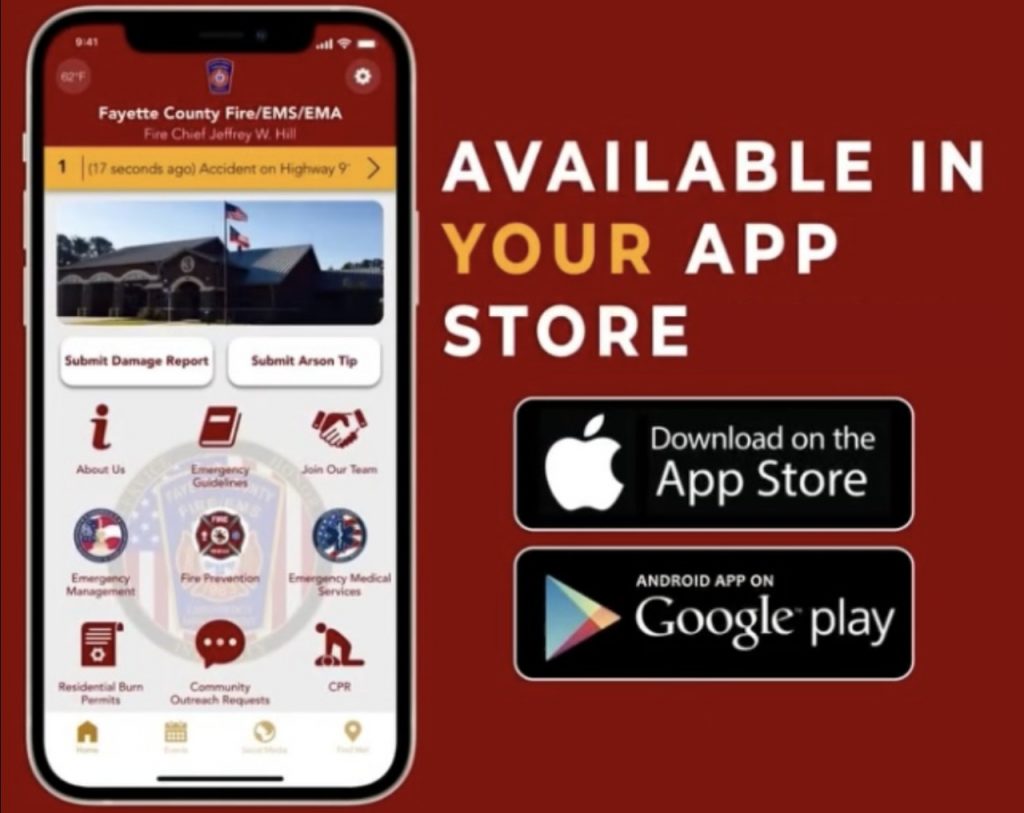
Fayette County Fire/EMS/EMA app now available for download. Photo/Fayette County Fire/EMS
- Stay Informed: The Fayette County Department of Fire and Emergency Services and the Fayette County Sheriff’s Office have new apps that will alert you to situations in our local area, including weather alerts, road closures, and other items of public interest. Download both of those apps from the Apple App Store or Google Play Store and turn on the messaging feature.
- Monitor the Weather: Although our public safety agencies relay official weather alerts, it’s also helpful to get those alerts directly from the National Weather Service. I recommend signing up for text alerts and having a Weather Alert Radio.
- Read/Listen/Watch the News: You’re obviously reading this column on a news website, but make sure you keep up with news from other sources. I’m a big fan of listening to broadcast radio, particularly WSB 750 AM/95.5 FM.
- Create an Emergency Plan: Know how you are going to escape your house, neighborhood, and local area if you need to evacuate. How are you going to communicate with family members if cell phones don’t work? Having backup communications is one reason my wife and I have amateur radio licenses. Have a backup communications plan. Also, consider other special needs like pets, infants, seniors, and individuals with disabilities.
- Build an Emergency Kit (aka “Go Bag” or “Bug out bag”): I keep a backpack ready to go in my car and another at home. It includes: water, water purification tablets, food, a first aid kit (I also carry a first aid kit in my laptop bag), tools & supplies, personal items, cash, documentation, hygiene products, battery chargers and cables, a change of clothes, inclement weather clothing, a flashlight, and a fire starter.
- Prepare Your Home: Ensure your home is ready by checking out the structure, fire escape routes, roofing, and possible areas of flooding. Know how to turn off utilities such as gas, water, and electricity if you need to do that yourself.
- Be Able to Protect Yourself and Your Family: I normally don’t make a big deal about it, but I do support the Second Amendment of the United States Constitution. Let’s just say that our family is prepared to exercise our Constitutional rights if that ever becomes necessary. I strongly encourage people, especially women, to take self-defense classes and have some type of personal defense system. There are some bad people out there, and sometimes an emergency brings out the worst in people.
- Just-in-Time Preparations: If I know a storm is coming, like I do right now, I will make sure all of my electronic devices are charged ahead of time and all of my radios, kits, and supplies are ready to be used if necessary.
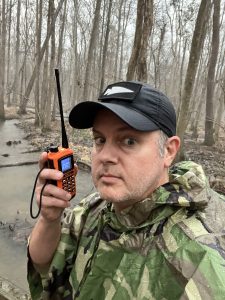
The author (FCC license: KI4ASK) using a waterproof, handheld VHF ham radio during inclement weather. Photo/Joe Domaleski
Preparation is the key to weathering a storm or any other emergency situation. Last week, when the power went out, we knew what to do immediately. Seeing that some lines were down on my car, I called the Fayette County non-emergency line at (770) 461-4357 (since no one was trapped or hurt), and Fayette County Fire came out to help assess the situation and clear the lines for me. NOTE: If it is truly an emergency or you’re not sure, then go ahead and dial 911. We were able to switch our internet connections to data hotspots so that we could keep watching the Olympics online that night. I used prepositioned flashlights to see around the house.
Because trees had fallen on our power lines, I knew it might take some time for the EMC to get to our house. The next morning, we got ready for work at our local gym, and I was able to work from my co-working office located at Roam at Trilith. Later that afternoon, I got a text message from my home HVAC system that the power had been restored. When I got home later that day, I saw that we had new power poles up in the yard. Thank you, Coweta-Fayette EMC. The whole situation could have been worse if we had not been prepared. We knew what to do, who to contact, and how to make alternate plans to keep things as normal as possible.
Stay safe this week by making plans now. What are some tips that you have for maintaining personal emergency preparedness?
[Joe Domaleski, a Fayette County resident for 25+ years, is the owner of Country Fried Creative – an award-winning digital marketing agency located in Peachtree City. His company was the Fayette Chamber’s 2021 Small Business of the Year. Joe is a husband, father of three grown children, and proud Army veteran. He has an MBA from Georgia State University and enjoys sharing his perspectives drawing from thirty years of business leadership experience. Joe is a recipient of the Peachtree City Rotary Club Business Leader of the Year Award for 2024. Sign up for the Country Fried Creative newsletter to get marketing and business articles directly in your inbox. You can connect with Joe directly on LinkedIn for more insights and updates.]
by Joe Domaleski | Jul 30, 2024 | Blog, Business, Columnists, Community, News Center, Opinion, Top News
The other day, someone asked me, “Joe, what are the three most important things to consider when marketing my business? I mean, how do I convince people to buy from me?” I thought about it for a few seconds and replied, “Marketing is simply communications designed to promote something. It’s a lot like having a personal conversation with someone, but done on a larger scale. Let me ponder this some more, and maybe I’ll write about it.” So here goes, my written reply.
It’s fairly self-evident that the battle for everyone’s attention in life is fierce. Whether you are marketing a brand, looking for information, or seeking out “design inspo,” there are many things out there vying for attention. Every brand, organization, and influencer competes not just to be seen but to be remembered and acted upon. I’m not immune from this, and sometimes my biggest challenge of the day is to just stay focused on one thing.
So, how can you avoid the marketing and communications mistakes many people make? What can you do to make your messages rise above the noise? I’ve given this a lot of thought, and I believe it’s three things: style, substance, and statistics. Let’s explore how these three alliterative elements work together to create professional communications that are not only eye-catching but also meaningful and measurable. Personal note—I wrote the title, not AI. My high school teacher Mrs. Prante would be proud of my use of alliteration in the title!
Style: The Art of Attraction
First impressions do matter, and it may not be fair, but people do tend to judge a book by its cover. The visual appeal of your communications (cover page, website, picture, video, sound, etc.) is what will initially draw your audience in. Be creative, but use a sense of style. Many people (you and me included) sometimes only look at the picture and form an impression about the whole message—that’s why internet memes are so popular (and dangerous).

CFC team members (L-R) Erica Caetano, Fran Glass, and Christina Colantonio work on the style and substance of a marketing campaign. Photo/Joe Domaleski
Style is more than the image or video; it encompasses the design, color schemes, typography, and overall aesthetics of your communications medium. It’s about creating a visual identity that clicks with your target audience. For example, I’m an early Generation X’er, and I am automatically drawn to things from the 80’s (especially the music, because we had the best music).
Style is also about creating an emotional connection with whomever you’re trying to communicate with. If you’re marketing, then a well-designed campaign should evoke feelings of trust, excitement, or curiosity. If you’re interviewing for a job or trying to sell a house, then ensuring everything looks good does matter. Style is the first step in capturing attention and sparking interest.
Substance: The Heart of the Message
Once you have your audience’s attention, you need to keep it. This is where substance comes into play. Substance is the depth and relevance of the content you provide. It’s the information, stories, and messages that add value (or entertainment) to your audience’s lives.
We are all bombarded with superficial content, which is increasingly being generated by AI (yuck). Substance is what differentiates meaningful engagement from fleeting interest. Your content should have depth and address the needs, pains, interests, and desires of your audience. It should educate, inspire, or entertain them in a way that communicates what you’re trying to say. Yes, humor counts because who doesn’t love a good cat video?
Substance requires you to understand what you’re trying to say and match that up with the interests of your audience. What are their challenges? What do they care about? What is their mood? By providing content that is relatable and relevant, you build trust and establish a connection with your intended audience.
Statistics: The Measure of Success
Style and substance are critical, but without statistics (aka metrics or analytics), you’re flying blind. Statistics help you understand if you’re reaching the right audience and if your message is being heard. Beware of vanity metrics if you’re using social media for your communications. If you’re into marketing like I am, there’s a whole bunch of things you can track. Analytics tools allow you to track a wide range of metrics, from website traffic and social media engagement to conversion rates and customer retention.
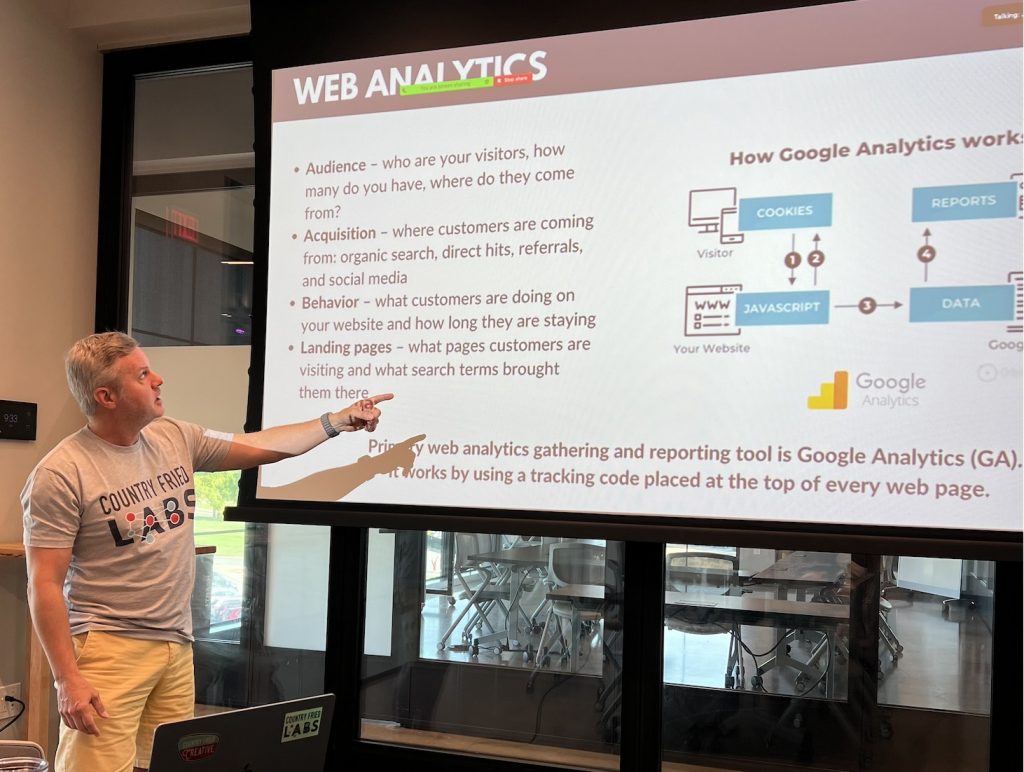
Joe Domaleski explains the essentials of website analytics with a focus group at Trilith. Photo/Christina Colantonio
Focus on these three essentials:
• Reach – How many people see your message?
• Engagement – How many people react to your message?
• Conversions – How many people take the action you want them to take?
The above metrics can be applied to marketing campaigns but can also be applied to a small group of people. Professional marketers might review statistics on an analytics dashboard. A homeowner’s association might make a pitch to a small group of people and immediately take a vote on something. The same three essential statistics apply regardless of the scale. By looking at the data, you can learn what’s working and what’s not, allowing you to refine your strategies and optimize your message for better results.
Statistics help you understand the impact of your style and substance. By regularly reviewing your data, you can make informed decisions that enhance your marketing and communications effectiveness.
The Synergy of Style, Substance, and Statistics
There’s a lot of great material out there about how to be an effective marketer and communicator. I’ve spent most of my career learning how to be a better communicator. But the more I think about it, it seems to me the essence of it lies in the synergy of style, substance, and statistics (alliteration again). When these elements are considered and combined, they create messages and stories that are not only attractive and meaningful but also impactful.
• Style captures attention and creates an emotional connection.
• Substance provides value and builds trust.
• Statistics measure success and guide improvement.
There’s a certain elegance in simplicity. Now, I challenge you to think about your own marketing and communications efforts. Are you incorporating style, substance, and statistics in your communications? Take a closer look at your next campaign or message. Ensure it’s visually appealing, filled with valuable (or entertaining) content, and then measure how well it’s doing. By giving thought to style, substance, and statistics, you’ll become a more effective communicator. I hope I’ve been an effective communicator in this article, and the statistics on this one are there for all the world to see (although popularity isn’t everything). Thanks for reading.
[Joe Domaleski, a Fayette County resident for 25+ years, is the owner of Country Fried Creative – an award-winning digital marketing agency located in Peachtree City. His company was the Fayette Chamber’s 2021 Small Business of the Year. Joe is a husband, father of three grown children, and proud Army veteran. He has an MBA from Georgia State University and enjoys sharing his perspectives drawing from thirty years of business leadership experience. Joe is a recipient of the Peachtree City Rotary Club Business Leader of the Year Award for 2024. Sign up for the Country Fried Creative newsletter to get marketing and business articles directly in your inbox. You can connect with Joe directly on LinkedIn for more insights and updates.]
by Joe Domaleski | Jul 23, 2024 | Blog, Business, Columnists, Community, News Center, Opinion, Top News
We need better marketing. You may be thinking, “I’m sick of ads, Joe. Why do I want more marketing?” Well, I said “better” marketing, not more marketing. Marketing helps people find things. Are you a start-up business trying to land new clients? Are you a consumer looking for specific products or services? Are you tired of swimming through irrelevant “noise” trying to find what you are looking for? Whether you’re selling something (product or idea) or buying something, you can be more effective with better marketing.
When I first entered the workforce in the early ’90s, I didn’t set out to become a professional marketer. Quite the contrary, I was leaving military service and trying to begin a career involving finance and technology. During my first decade in the workforce, I saw how important marketing and sales were in business. Whether I was trying to sell or promote something or find something, marketing was involved. Marketing, at its core, is the process of promoting and selling products, services, and even ideas.
Traditionally, business schools have struggled to teach small business marketing, and they definitely don’t do a good job teaching sales. This problem has worsened as algorithmic marketing and sales have amplified loud voices, making them louder. It’s getting harder and harder to promote and find quieter voices. Let’s fix that. In this article, we’ll explore what “better” means in the context of marketing and how it can be achieved whether you’re a buyer or seller.
Starting With Definitions
Let’s start with the definition of “better.” The word “better” refers to an improvement or a higher standard of quality, performance, or condition compared to a previous state. It signifies a positive change or progression. In everyday use, “better” often implies superiority or preference, suggesting that something is more desirable, efficient, or effective. Admittedly, the concept of “better” is subjective, as it depends on individual perspectives, goals, and criteria for what constitutes an improvement. To me, “better” implies the pursuit of excellence and the striving for quality.
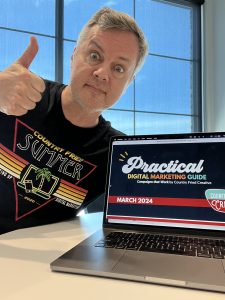
Businesses and customers deserve BETTER MARKETING. Photo/Joe Domaleski
The word “marketing” is based on the word “market,” so let’s consider that first. A “market” is a place where people exchange goods, services, and ideas. We like to talk about living in a “free market” society. A market can be physical, such as a grocery store, community festival, auction hall, or even a shopping mall. It also extends to the virtual world in the form of online shopping, forums, and social media. Marketing, simply stated, is the promotion of products, services, and ideas so that interested parties know about them in the hopes that they will buy or accept them. In short, marketing helps people find things of interest.
Marketing Through the Eyes of the Buyer
As buyers, we are constantly bombarded with marketing messages. Some of these are enjoyable, like high-quality commercials that entertain, inform, and even inspire us. Think of the heartwarming holiday ads from major retailers or the clever and humorous spots during the Super Bowl. These commercials resonate because they connect with us on an emotional level, tell a story, or provide a memorable experience.
On the flip side, there are ads that annoy us. These are often intrusive, irrelevant, or overly repetitive. For example, pop-up ads on websites or irrelevant ads that follow us around online can create a negative perception of the brand. For buyers, better marketing means receiving messages that are relevant, respectful, and valuable.
Marketing Through the Eyes of the Seller
For sellers, marketing is a tool to reach potential customers and persuade them to buy products or services. Effective marketing can drive sales, build brand loyalty, and differentiate a business from its competitors. However, achieving better marketing requires understanding and addressing the needs and preferences of the target audience. High-quality commercials work well because they align with the brand’s values and the audience’s expectations. They are crafted with care, focusing on storytelling, aesthetics, and emotional appeal. Sellers must avoid practices that irritate potential customers, such as aggressive sales tactics, misleading information, and over reliance on AI-generated content (one of my pet peeves).
Marketing Beyond Commerce
Marketing is not confined to commerce; it extends to any area involving promotion, publicity, or persuasion. Nonprofits use marketing to increase awareness, recruit volunteers, and raise funds. For a nonprofit, marketing is essential to enable them to support vital causes and reach those in need. Politicians use marketing to win votes, shape public opinion, and communicate their policies and visions to the electorate. As I write this, we in the middle of a historic Presidential election where we can see the impact of marketing first hand. Individuals use marketing to build personal brands on social media to showcase their skills, share their stories, and connect with like-minded communities. Educational institutions market their programs to attract students, while advocacy groups use marketing strategies to drive social change and mobilize supporters. In essence, marketing is a powerful tool for anyone seeking to influence, inform, or engage an audience, regardless of the context.
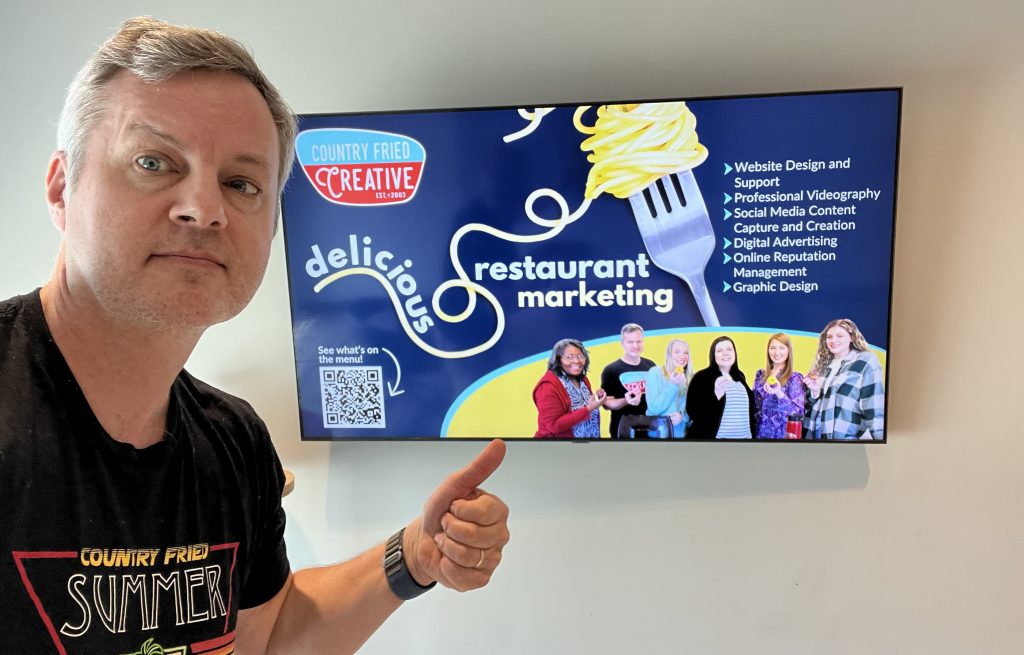
Helping local restaurants implement BETTER MARKETING. Photo/Joe Domaleski
Example Situations That Need Better Marketing
Here’s some real world examples in our own community that could benefit from better marketing:
- Entrepreneurs trying to land their first client.
- New restaurants looking for customers.
- Families looking for community events.
- Governments recruiting new law enforcement officers.
- Nonprofits hoping to increase monthly giving.
- Existing businesses promoting a new product or service.
- Homeowners looking for a reputable lawn care service.
- Recent college graduates looking for new jobs.
- Animal adoption agencies looking for fosters.
- Struggling families looking for food assistance.
How can we help people find what they are looking for? Better marketing! I’ve built most of my career around marketing, particularly community marketing. Over the years, I’ve seen a lot of bad marketing. Let’s turn that around. Here’s my Better Marketing Manifesto on how we can all do a better job.
Better Marketing Manifesto
- Know your audience – Understand who they are, what they need, and how they behave. Doing that will help ensure your message is relevant.
- Create value – Offer products, services, and information that is of interest to your audience. It’s not about you, it’s about them. Focus on solving their problems and enhancing their lives. By prioritizing value, you build trust and loyalty.
- Tell a story – Connect with your people emotionally by using storytelling. Stories help humanize your message and create a deeper connection with people.
- Be authentic – Be genuine and sincere in your marketing message. People can spot a fake – whether it’s a fake AI-generated image or a false promise of success. It’s okay to be optimistic, but be realistic too.
- Maintain consistency – It’s important that messaging, branding, and tone are consistent across all marketing channels (web, social media, in person). Consistency reinforces your brand identity and reliability by establishing a strong, recognizable image in the minds of people.
- Engage and listen – Actively interact with people to make them feel heard and valued. Engagement shows people that you value their input and are committed to helping them.
- Ground your strategy in data – Use analytics to track performance, understand trends, and make informed decisions to optimize your efforts. Data-driven decisions lead to more effective and efficient marketing outcomes. This also helps your target audience find what they are looking for quicker.
- Respect privacy – Safeguard personal information and be transparent about how you use data. Prioritize consent and adhere to privacy laws and regulations to build trust and safeguard your audience’s trust. Respecting privacy not only complies with legal requirements but also enhances your reputation as a trustworthy brand.
- Adapt and innovate – Watch the market and consider embracing new technologies and trends where appropriate. Be willing to adapt your strategies to keep your marketing fresh and effective. Continuous innovation ensures that your marketing remains relevant and competitive.
- Focus on good – If I was to summarize my better marketing manifesto with a single point, it would be this – focus on doing good. Highlight the ways your products, services, or initiatives contribute to the betterment of all concerned (sound familiar, Rotarians?). Marketing is not about forcing anyone to buy or accept anything. By focusing on good, you inspire trust and support from people.
Let’s commit to better marketing. Whether you are a business owner, a marketer, or simply someone looking to make a difference, it’s time to up your game. Big organizations are not likely to take the lead on this. I think this has to start in our local community—businesses, nonprofits, governments, and consumers. Imagine a community where better marketing not only promotes products and services but also enriches lives by promoting local economic growth and supporting worthy causes. Better marketing can help foster connections between people in all areas of our community, helping people find what they are looking for and not just what algorithms want you to know about. Helping people is the heart of better marketing.
[Joe Domaleski, a Fayette County resident for 25+ years, is the owner of Country Fried Creative – an award-winning digital marketing agency located in Peachtree City. His company was the Fayette Chamber’s 2021 Small Business of the Year. Joe is a husband, father of three grown children, and proud Army veteran. He has an MBA from Georgia State University and enjoys sharing his perspectives drawing from thirty years of business leadership experience. Joe is a recipient of the Peachtree City Rotary Club Business Leader of the Year Award for 2024. Sign up for the Country Fried Creative newsletter to get marketing and business articles directly in your inbox. You can connect with Joe directly on LinkedIn for more insights and updates.]
by Joe Domaleski | Jul 16, 2024 | Blog, Business, Columnists, Community, Front Page, News Center, Opinion, Top News
Over the years, I’ve come to understand that the success or failure of both business and personal endeavors most often depends on a single factor—our relationships with people. That’s not to say it is the only factor, but it does seem to have the most influence. No amount of money, automation, expertise, or sheer willpower can fix a broken relationship. Broken relationships can derail projects, lose customers, run off good employees, start wars, end marriages, and cause all sorts of problems.
When it comes to relationships, things often fall along a spectrum between negative sentiments like blame and good feelings like praise. Whether we are assigning blame for a project’s failure or giving praise for a job well done, these actions shape our relationships and can significantly impact the success of our business and personal lives. NOTE: I am not a psychologist, so this article is just my personal opinion and should not be construed as professional medical advice.
If you’ve read some of my previous articles, you know that I have a background in math and science. We regularly apply data science principles to the work we do at my marketing agency. Most of our staff do creative work, and they excel at that. Since their work is done in a business context, that creativity is applied to helping clients reach their marketing goals. In order to be effective, we apply data science and analytics to measure, assess, and even predict marketing results.
You can have the most creative marketing campaign in the world, but if no one sees it, then that campaign is not likely to succeed. What if we apply some of those same principles to relationships? Both marketing and relationships deal with people. All too often, good intentions, like great creativity, don’t necessarily translate to better results or better relationships. So indulge me a moment while I assume the role of a data scientist to explore some characteristics of business and personal relationships.
Like any good scientist, I’m going to start by defining some key terms. These terms could apply to people or non-corporeal entities, but we’re going to focus on people:
• Relationship: The way in which two or more people are connected, interact, and affect each other.
• Blame: The act of holding someone responsible for a fault or wrong.
• Praise: The act of expressing approval or admiration for someone’s actions or achievements.
• Attribution: The process of determining the cause or reason behind an outcome or event.
• Agents: The individuals or entities involved in actions or events, often the subjects of attribution.
In both business and personal contexts, the way we assign blame and praise plays a crucial role in shaping our relationships and interactions. All too often, people fall victim to personal biases, stereotypes, and even media influences to falsely blame or praise others. Misattributions like that are normally done as an emotional response with very little thinking involved. By understanding these dynamics with an open heart and open mind, we can foster healthier and more productive connections. Now, let’s delve deeper into the key characteristics of relationships using data science to better understand other people:
Key Characteristics of Relationships from a Data Science Perspective
Direction: Simply put, a relationship tends to either be a positive one or a negative one often fluctuating between the two directions.
• Positive Relationship: When we give praise, we often see positive outcomes such as increased motivation and improved performance. For example, acknowledging an employee’s hard work can boost their morale and productivity. Of course, falsely giving praise can backfire and be misinterpreted as insincerity.
• Negative Relationship (Inverse): Assigning blame can lead to negative outcomes such as decreased trust and lower morale. For instance, blaming a team member for a project’s failure can result in resentment and reduced collaboration. Yet, there are times when a failure needs to be acknowledged so that improvement can occur.
Magnitude (Strength): The impact of blame and praise can vary in intensity. Strong attribution of praise can lead to significant improvements in relationships and performance, while strong attribution of blame can cause severe damage to trust and cooperation.
Form: Imagine for a moment that we were graphing a relationship on a standard cartesian plane (aka “x/y graph”).
• Linear Relationship: Consistent recognition of effort (praise) can steadily improve performance over time. Such a graph would should a consistent rate of improvement.
• Non-linear Relationship: Blame may have a more complex relationship, where occasional blame might not have a significant impact, but repeated blame can exponentially harm relationships and performance.
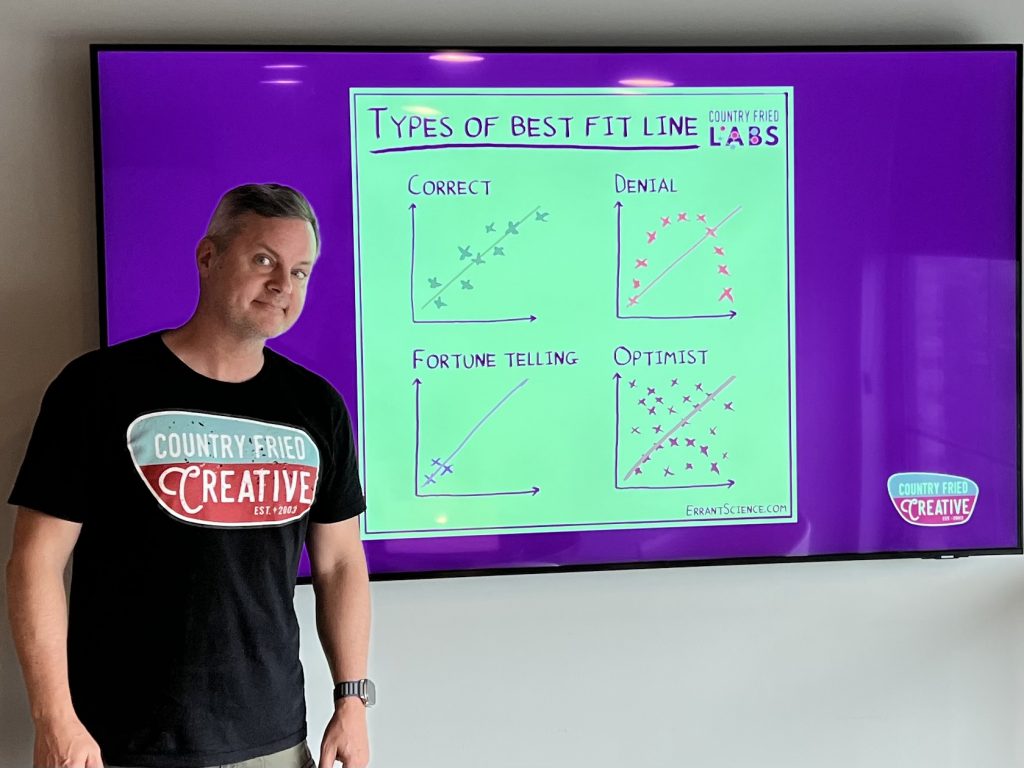
The author explaining some humorous examples of best fit lines on an x/y graph. Photo/Sophie Castellon
Causality: Directly attributing success to an individual’s actions (praise) can encourage continued positive behavior. Conversely, directly attributing failure to someone’s actions (blame) can discourage and demotivate them.
Association: Understanding the context and factors associated with outcomes can help in fair attribution. For instance, recognizing external factors that contributed to a project’s failure can prevent unfair blame and foster a more supportive environment.
Direction of Influence:
• Unidirectional Relationship: Sometimes, praise or blame might flow in one direction, such as from a manager to an employee. In general, this isn’t a good model for long-term success in a relationship.
• Bidirectional Relationship: In healthy relationships, both business and personal, there’s often a two-way street of giving and receiving praise and blame, which helps in maintaining balance and mutual respect.
Consistency: Fair and consistent attribution of praise and blame builds trust and reliability in relationships. Inconsistent attribution, on the other hand, can lead to confusion and distrust. This can be hard to do, and some people have long memories and “keep score.” It’s been my experience that consistency is one of the most important relationship characteristics. Blaming other people has never been one of my strong suits, although some people excel at blaming others for everything.
Temporal Precedence: I really just wanted to use that word – temporal, which simply means something is related to time. Ensuring that attributions of blame or praise are timely can make them more meaningful and effective. Immediate recognition or constructive feedback tends to have a greater impact. In other words, try to acknowledge the situation as quickly as possible and don’t save it up for later.
Leadership and the Role of Blame and Praise
Leadership plays a critical role in how blame and praise are managed within a business. Effective leaders understand the importance of taking responsibility for failures and assigning praise to others for successes. This approach not only builds trust but also fosters a positive and productive work environment. Unfortunately, many leaders have forgotten how to do this. Here’s three things to consider in that regard.
1. Leaders and Blame: Good leaders are quick to take blame when things go wrong. This shows accountability and protects the team from undue criticism. It also encourages a culture of learning from mistakes rather than fear of retribution. By taking blame, leaders can redirect the focus towards finding solutions and improving processes, rather than getting bogged down in fault-finding.
2. Leaders and Praise: Effective leaders generously ascribe praise to their team members. Recognizing and celebrating individual and team achievements boosts morale and motivation. This does not mean “everyone is a winner”. Quite often, there is a single winner in a contest or competition. Assigning praise where it’s due reinforces positive behaviors and encourages a culture of appreciation and recognition.
3. Avoiding Toxicity: Leaders must be vigilant against toxic behaviors, such as individuals who constantly blame others or look for causation where none exists. These behaviors can undermine trust and collaboration within the team. Addressing and mitigating toxic behaviors promptly helps maintain a healthy and supportive work environment. This is one of my biggest pet peeves in dealing with people – the Schleprocks and Eyeores of the world who are always negative about everything.
Relating This Back to Relationships
In business, understanding how we assign blame and praise can transform team dynamics and performance. By giving praise where it’s due and fairly attributing blame, we foster a culture of accountability and appreciation. This not only enhances individual motivation but also strengthens team cohesion. In my company, we try to do that with regular team recognitions. On a daily basis, this happens in our company group chat. On a monthly basis, this happens at our all-hands team meeting.
In our personal lives, the principles are similar. Recognizing and appreciating the efforts of our loved ones while being mindful of how we assign blame can improve our relationships. Constructive feedback, combined with genuine appreciation, can build a foundation of trust and mutual respect. In many ways, this is harder to manage at home than it is in the workplace. In a previous article, we examined the five love languages, and you might find some good tips about how to enhance relationships in that article.
Final Thoughts
Ultimately, the way we manage blame and praise in our relationships will have a direct impact on the probability of success or failure in your endeavors. By focusing on fair attribution and recognizing the positive contributions of others, we can create an environment where everyone feels valued and motivated. This approach not only drives success in business but also nurtures healthier, happier personal relationships. The key is to balance blame and praise thoughtfully, fostering a culture of growth, appreciation, and mutual support.
I would encourage you to take a closer look at how you assign blame and praise in your daily interactions. Using key concepts from data science that we explored earlier in this article can help provide a framework for managing your relationships. Reflect on your personal and professional relationships, and consider how fair attribution can make a difference. Start by giving genuine praise where it’s due and taking responsibility when things go wrong. Encourage a culture of constructive feedback and appreciation, both at work and at home. By doing so, you can contribute to building stronger, more positive relationships that benefit everyone involved.
[Joe Domaleski, a Fayette County resident for 25+ years, is the owner of Country Fried Creative – an award-winning digital marketing agency located in Peachtree City. His company was the Fayette Chamber’s 2021 Small Business of the Year. Joe is a husband, father of three grown children, and proud Army veteran. He has an MBA from Georgia State University and enjoys sharing his perspectives drawing from thirty years of business leadership experience. Joe is a recipient of the Peachtree City Rotary Club Business Leader of the Year Award for 2024. Sign up for the Country Fried Creative newsletter to get marketing and business articles directly in your inbox. You can connect with Joe directly on LinkedIn for more insights and updates.]
by Joe Domaleski | Jul 9, 2024 | Blog, Business, Columnists, Community, News Center, Opinion, Top News
This past weekend many of you probably enjoyed a long Independence Day holiday. Not everyone had a long weekend; many people still had to work while others enjoyed time off. Front-line workers were still on duty keeping us safe, protecting our freedoms, and helping “mind the store” so that the rest of us could shop, eat, and play. Although I had to work a little over the weekend, for the most part, I got to enjoy family time and even some quiet reflection.
Last week we explored the Declaration of Independence and what the Spirit of 1776 means in 2024. I’d like to finish the theme by turning our attention to the activities that put those words of Independence into action. The words were bold, but the actions that followed were even bolder. When our great country declared Independence on July 4, 1776, direct combat operations had already begun. After the Declaration, front-line combat operations escalated dramatically.
What are front-line operations?
In the military, front-line operations are where soldiers directly engage with the enemy. Sometimes the front line is well-defined, and at other times it resembles guerrilla warfare, where things aren’t so clear. Regardless of the ambiguity, the front line is critical for both offensive and defensive operations. Operating from the front line requires bravery, quick thinking, and effective communications. When I was in the Army, we were often told our mission was to “shoot, move, and communicate.”
In business, front-line operations refer to direct interactions between a business and its customers and critical business partners. These operations include customer service, sales, and support. Both business and military front-line operations involve potentially high-stakes direct engagement that can significantly impact overall outcomes. We’re going to focus on front-line operations in business, where team members are the face of the company, representing its value and brand in every interaction.
Examples of front-line operations in business:
- Customer Service: Handling general inquiries, questions, complaints, requests, and feedback regarding products and services.
- Sales Interactions: Engaging potential customers to listen to their needs, propose solutions, and close new deals that benefit the customer and the business.
- Technical Support: Assisting customers with technical issues or questions related to a product or service.
If there’s a front line, then it has to be supported by back-end operations, “aka supply chain.” Back-end operations support the front-line by handling administrative tasks, data management, logistics, and IT. Examples include processing payroll, managing inventory, and maintaining IT infrastructure. While back-end operations ensure that the company runs smoothly behind the scenes, front-line operations directly influence customer satisfaction and brand perception. You need both front-line and back-end operations to be successful in business, but oftentimes front-line operations are more stressful. Why is that? Because it’s mostly about dealing with people and all of the good and bad that comes with that.
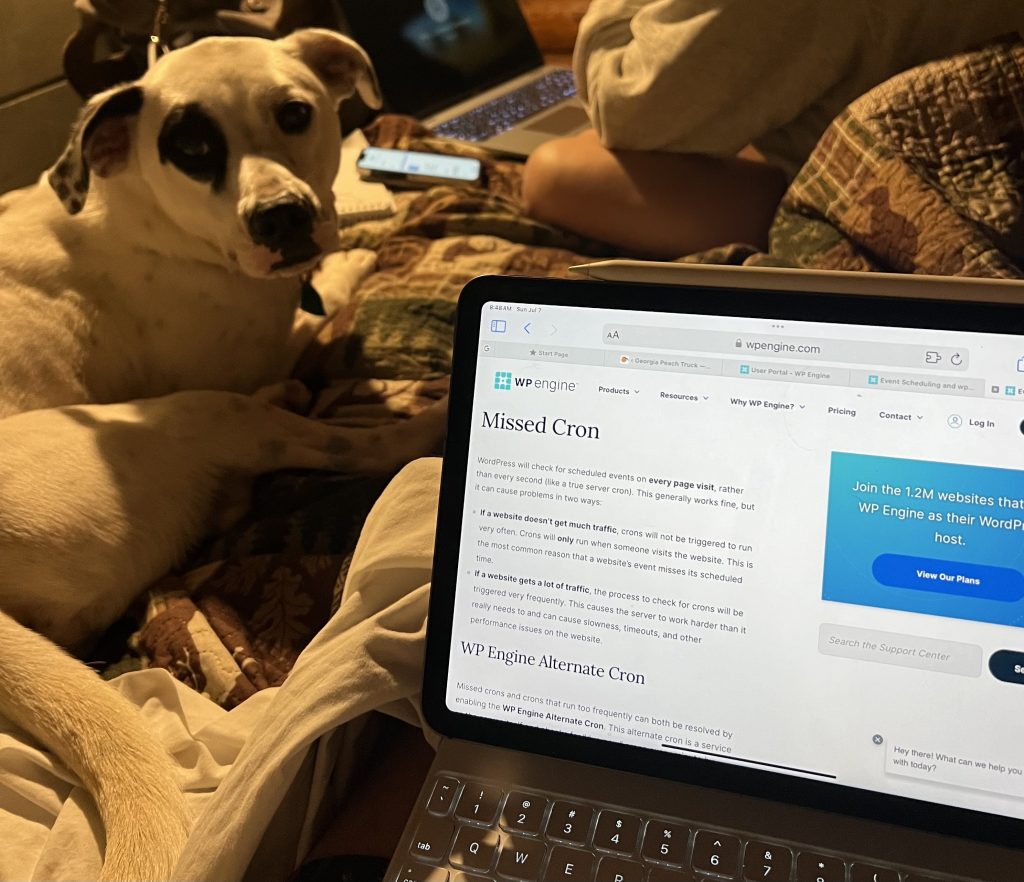
Sometimes being on the front lines means working during a holiday weekend. Our dog Loki looks on while I research a problem for one of our high-profile web support clients from our cabin on Lake Hartwell 7/7/24. Photo/Joe Domaleski
I believe in front-line leadership. An effective leader should position themselves where they can best lead. In business, a leader needs to lead by example and not hide in the background. For me, that means staying directly involved in sales and customer service. Over the years I’ve learned a few things about operating from the front-line.
A leader has to be able to be client-facing. Leaders who hide behind others are not true leaders.
Some tips for being effective from the front line:
- Focus on the goal: Whether it’s making a sale, answering a question, or solving a problem, it’s essential to focus on the goal. A lot of distractions occur on the front lines. Don’t let the “fog of war” cloud the way.
- Stay calm and composed: Handle high-pressure situations with a clear mind. It’s hard to not get excited about a tense situation, but expressed frustration rarely solves problems.
- Listen actively: Seek to understand what’s going on and what needs to happen. Oftentimes, you may get conflicting information and have to use discretion to sort things out.
- Communicate clearly: Use clear, concise, and positive language. This may not be easy when the other party is not communicating clearly. Repeat back what was heard.
- Be proactive: Anticipate issues and address them before they escalate. This comes with experience, and the only way to develop that experience is to get involved.
- Maintain a positive attitude: Believing that something can be done is half the battle. A positive demeanor can diffuse tension and build rapport.
- Document and follow up: Here at my company, we always take meeting notes and send them back to clients to record what was discussed. This helps build consistency and ensures that we accomplished the goal.
- Document and learn: We also keep records of issues and resolutions for our team. It helps our staff learn and improve. It also comes in handy if we need to refer to it later when someone’s memory is less than perfect.
- Set a sustainable pace: One of the most important tips is to pace yourself when getting involved in a potentially long-running front-line situation. It’s exhausting to be on a long phone call, video chat, or meeting. More than once I’ve politely told someone we can either talk about a problem or we can spend time on doing the work to solve a problem. There is a point of diminishing returns when it comes to discussions (and this is coming from a guy who likes to talk).
Being on the front lines can be exhausting. Leaders should rotate team members and shifts so that no one gets overloaded. It’s especially important that a leader rotate off the front lines so that they don’t get fatigued and make fatal errors. Although it’s industry dependent, a good rule of thumb is to not allow someone to work more than a 12-hour shift on the front lines. There are exceptions to that for the military, fire departments, and other emergency / essential services.
Some risks from staying on the front lines for too long:
- Burnout: High-pressure environments can lead to stress and burnout. It’s important to have shift changes and set realistic pacing goals when someone is “holding down the fort.” No one likes to be alone on the front line.
- Miscommunication: Misunderstandings can escalate issues. Left unchecked, miscommunications can lead to other negative consequences. This is why I believe it’s best to tackle issues head-on and not “ghost” someone by walking away from an issue.
- Negative interactions: Handling difficult customers can be challenging. Customers are not always right, and some people just don’t want to be happy. I fired a client two weeks ago because they decided to use inappropriate language with my team members.
- Inadequate support: Lack of support from back-end operations can hinder effectiveness. When someone is handling a front-line situation, they need to be able to count on their teammates for support.
- Reactive approach: Being constantly reactive rather than proactive can reduce efficiency and effectiveness. It’s a fact of life that some people don’t plan and expect there to always be someone on the other end ready to help. They don’t mind transferring their poor planning to someone else and making non-emergency situations urgent. Don’t be that person. Emergencies can and will happen, so save the urgency for truly important matters that can’t be avoided. If you’re on the receiving end of a steady stream of avoidable “emergencies” it’s okay to call a timeout and reset the expectations.
One of the things I enjoy most about running a small business is being able to operate from the front lines. For those who know me personally, I have a hard time sitting still and enjoy being where the action is. A strong front line can empower your organization to reach new heights. You’ll learn more and grow faster by being able to effectively operate from the front lines. A weak front line will adversely affect your organization and may imperil its future. Being effective on the front line requires a blend of skills, strategies, and a proactive mindset.
Investing in front-line leadership and training pays off in the long run, creating a team that is skilled, confident, and proactive. Effective front-line operations bridge the gap between an organization’s goals and the customer’s experience. I believe a leader should prioritize the importance of clear communication, active listening, and maintaining a positive attitude. Make a commitment to prioritize front-line excellence. Whether in a business or military context, the front line is where the action happens, and being prepared can make all the difference.
[Joe Domaleski, a Fayette County resident for 25+ years, is the owner of Country Fried Creative – an award-winning digital marketing agency located in Peachtree City. His company was the Fayette Chamber’s 2021 Small Business of the Year. Joe is a husband, father of three grown children, and proud Army veteran. He has an MBA from Georgia State University and enjoys sharing his perspectives drawing from thirty years of business leadership experience. Joe is a recipient of the Peachtree City Rotary Club Business Leader of the Year Award for 2024. Sign up for the Country Fried Creative newsletter to get marketing and business articles directly in your inbox. You can connect with Joe directly on LinkedIn for more insights and updates.]









